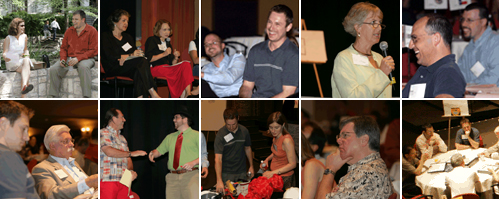 |
|
EMPOWERING
The opening session of the conference was designed to enable participants to engage in a healthy dialogue through knowledge. A series of presentations were made on past events such as the 1999 Internship Summit and 2002 Internship Summit and recent surveys such as the 2005 Internship & Career Survey. A highlight of this session was Internship: The Emerging Professionals' Perspective where the students, interns and young architects were asked to share their perspectives on internship today.
|
INNOVATING
The second session of the conference began with a series of presentations from an educator and two practitioners innovation in the integration of education and practice. The group then engaged in an extended discussion stimulated by fresh ideas for the architecture profession. Working groups were encouraged to develop and perform skits about the intern/supervisor relationship.
|
|
|
|
|
|
|
|
Ken Schwartz, FAIA
Jane Weinzapfel, FAIA |
ENVISIONING
The second day began with an enlightening presentation by Dr. Ed Zalneratis on the medical internship model. The participants were encouraged to use the information shared by Dr. Z in their group work later that day. The Emerging Professionals group presented a series of independent recommendations directly from the students, interns and young architects at the conference. Finally, the working groups presented their ideas for designing tomorrow's architect.
|
CONNECTING
On the last morning of the conference, representatives of the five collateral organizations held a press conference to share their insights as to the conference proceedings. The full and unedited statements made by the representatives is shared here. You may also wish to read the official press release which summarizes the outcomes of the conference.
|
|
|
|
|
|
|
|
Dr. Edwin Zalneratis
Frank Guillot, FAIA |

For conference papers, speaker biographies, and more information on the 2005 Internship Conference, please visit www.designingtomorrowsarchitect.org |
 |
| ** These audio recordings are copyrighted works owned by The American Institute of Architects ("AIA") and The National Council of Architectural Registration Boards ("NCARB") and may not be distributed without the copyright owners' permission. |
|

